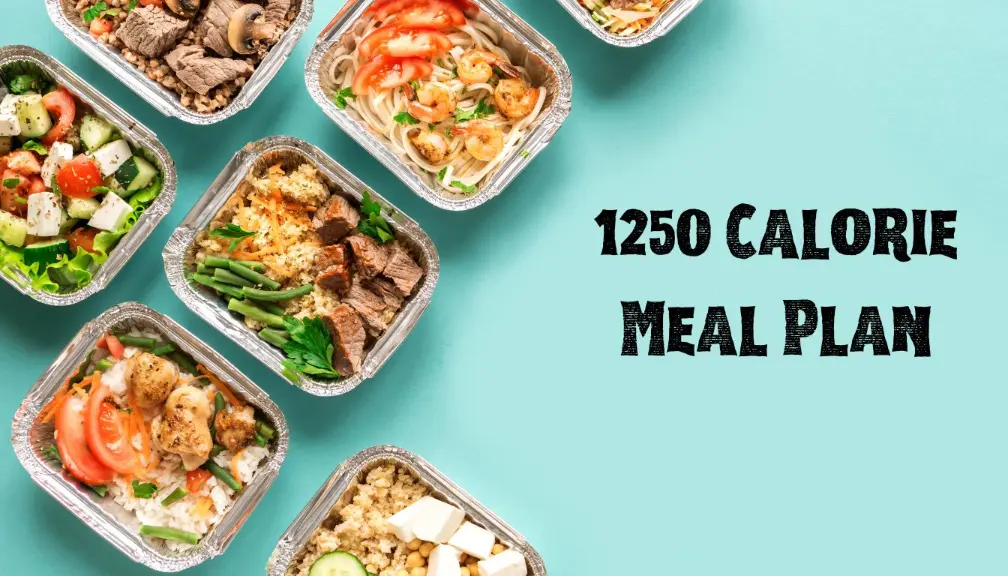Alright, let’s cut straight to it. You see it everywhere, that number: 1250 calorie meal plan. Like some magic ticket promising quick weight loss. Maybe you’re considering even lower intakes like 700 calories a day or ABC Diet meal plans, deep in your fitness journey, sweating it out, but the results aren’t showing up fast enough.
That 1250 calories a day target starts looking damn tempting, a simple diet plan for weight loss in a sea of confusing advice. But let’s hit pause. This isn’t just any diet meal plan; it’s a strict low-calorie diet, a serious form of calorie restriction. For many, especially active people, blindly chasing this number is like playing roulette with your metabolism, energy levels, and hard-earned muscle.
So, what’s the real story behind this popular 1200-1250 calorie approach? Is it a viable plan for weight loss, or mostly hype? Let’s take a cold, hard look. Heads up: This is information, not medical advice. Always chat with your doctor or a qualified nutritionist before making big diet changes.
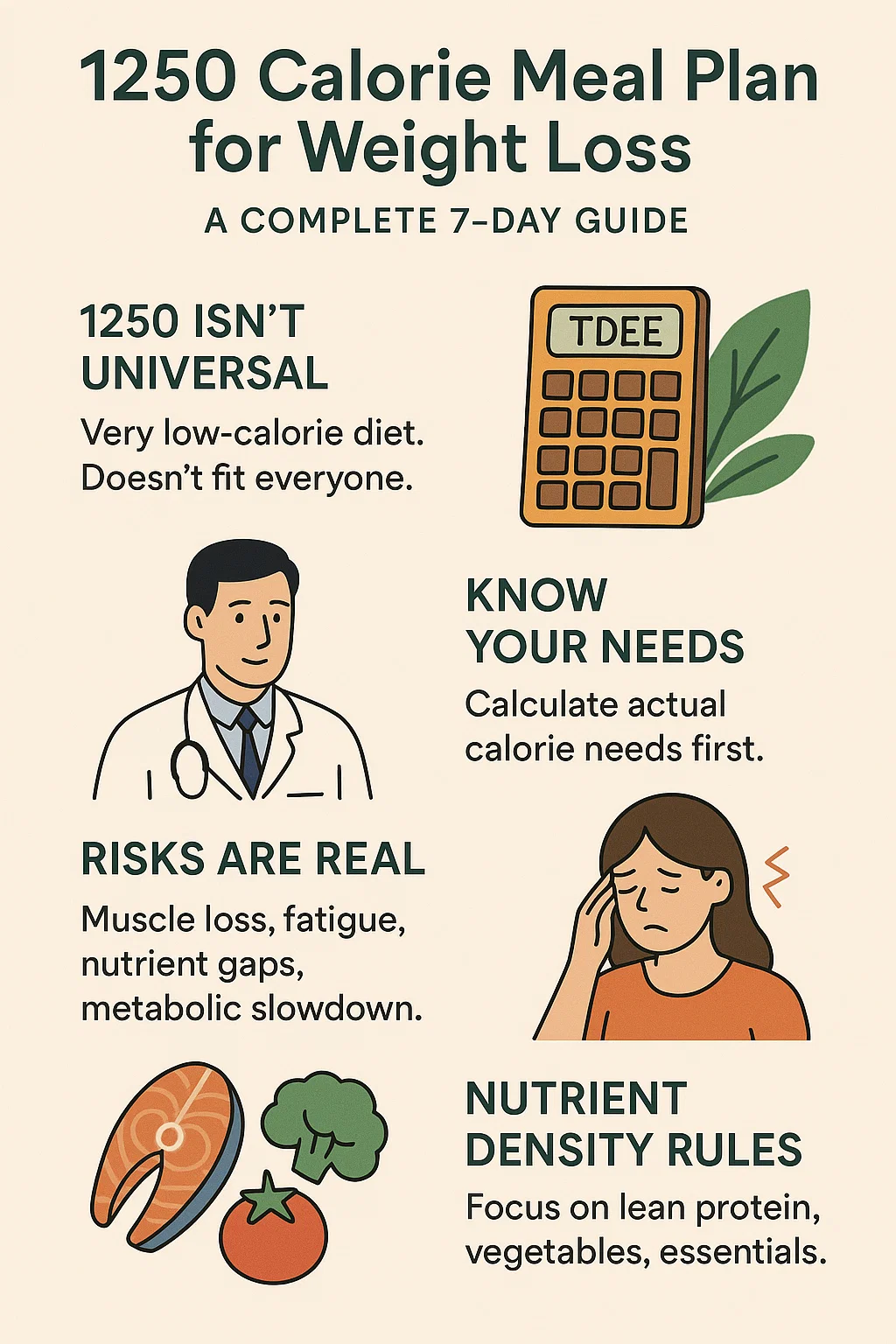
🚨 Your Health Comes FIRST: Medical Disclaimer 🚨
Before we go any further, this is crucial: This article is for informational purposes ONLY. It is absolutely NOT a substitute for professional medical advice.
Key Takeaways:
- 1250 Isn’t Universal: It’s a very low-calorie diet. Don’t just assume it fits your body weight or activity level.
- Know YOUR Needs: Your body is unique. Use a TDEE calculator or calorie calculator to estimate your actual daily needs before setting a calorie goal.
- Get Professional Advice: Talk to your doctor, a registered dietitian, or a qualified nutritionist before slashing calories this low, especially with medical conditions.
- Nutrient Density Rules: On any low calorie plan, make every bite count. Focus on lean protein (foods rich in protein), fiber from non-starchy vegetables, and essential nutrients.
- Risks are Real: Extreme restriction risks loss of muscle, fatigue, metabolic slowdown, and nutrient gaps. Aim for healthy weight loss, not just speed.
Listen to Your Body: Constant low energy levels, extreme hunger, dizziness? Red flags. Your weight loss journey shouldn’t compromise your overall health.
Cracking the Code: What’s Behind the 1250 Calorie Diet Number?

Why This Specific Calorie Count?
So, 1250 calories per day. Seems precise. Often, this number, or the common 1200 calories, gets suggested as a generic target to lose weight, particularly for smaller, less active women. The logic appears simple: eat fewer calories than you burn, create that calorie deficit, weight loss follows.
Your Body vs. The Meal Plan: Why One Size Fits None
But it’s not that simple. Your body is a complex, adaptive machine. Your real daily calorie needs (TDEE) are personal. They depend on:
- Size & Weight: Height and current weight.
- Sex: Men usually burn more.
- Age: Metabolism shifts.
- Muscle: More muscle burns more calories at rest. Your body composition matters.
- Activity Level: Huge difference between a desk job and intense training. How much physical activity do you really do?
- Health: Hormones, health conditions like type 2 diabetes, medications impact needs.
For many active adults, consuming only 1250 calories a day is less than their Basal Metabolic Rate (BMR) – the energy needed just to live and breathe. Running the engine below idle guarantees sputtering. This severe calorie restriction can mess with energy levels and even lead to rebound weight gain if your metabolism slows down too much.
Action Point: Stop using generic numbers. Calculate your estimated TDEE. That’s the starting point for a realistic, personalized meal plan.
Red Flags: Who Should Avoid This Low Calorie Diet Plan for Weight Loss?
When 1250 (or 1200 Calories) Isn’t Enough
Let’s cut the BS. For many people serious about fitness, this kind of low calorie diet plan for weight loss is a mistake without professional guidance. Steer clear if you are:
- Male: Your baseline needs are almost always higher.
- Active: You train hard. You need fuel. 1250 calories likely won’t cover intense workouts or significant physical activity.
- Tall or Larger Framed: More body mass needs more energy.
- Pregnant or Nursing: Absolutely not. Focus on nutrient-dense foods.
- A Teenager: Growth demands adequate fuel.
- Have Health Conditions: Type 2 diabetes, thyroid issues, PCOS need tailored nutrition plans from a doctor or nutritionist, not just reducing calorie intake drastically. Careful blood sugar control is essential.
- History of Disordered Eating: Highly restrictive plans can be harmful triggers.
- Feeling Good & Strong: If your current plan works, why embrace deprivation? Focus on quality and sustainable habits.
The Unspoken Truth: Risks of a Strict Calorie Meal Plan Like This
More Than Just Weight Loss: Muscle, Energy, and Metabolism Hits
Even if a pro okays a temporary, monitored 1200 calories per day, know the risks. This isn’t about fear; it’s about reality:
- Nutrient Deficiencies: Getting all essential nutrients is incredibly hard on so few calories. This impacts energy levels and overall health.
- Loss of Muscle: Your body might break down precious muscle tissue for fuel. Less muscle = slower metabolism. This hinders long-term weight management.
- Energy Drain: Feeling constantly wiped, irritable, foggy? Your body is running on empty.
- Metabolic Slowdown: Your body adapts to chronic restriction by becoming more efficient, burning fewer calories. This makes future weight loss harder.
- Hormonal Issues: Can disrupt crucial hormones affecting hunger, stress, and more.
- Gallstones: Rapid weight loss increases this risk.
- Sustainability Issues: Constant hunger makes long-term adherence near impossible. This diet meal plan rarely leads to lasting change.
If You Must: A High Protein Meal Plan Approach to the 1250 Calorie Diet?
Nutrient Density: Your Only Ally in a Low Calorie World
IF—and only IF—a 1250 calorie meal plan is professionally deemed right for you temporarily, then nutrient density is paramount. Every calorie must provide maximum nutritional value. This plan may work better if it’s high-protein.
Forget empty calories. Focus intensely on:
- Lean Proteins: Chicken breast (e.g., 100g portion), fish, turkey, eggs/egg whites, tofu, beans, lentils, Greek yogurt, cottage cheese. Aim for adequate grams of protein (e.g., 70-100g or more, depending on needs) distributed throughout the day. Look for foods rich in protein. Some plans aim for 27g protein per meal.
- Non-Starchy Vegetables: Load up! Spinach, broccoli, peppers, zucchini, leafy greens. Provide volume, fiber, vitamins for minimal calories.
- Complex Carbs (Small Portions): Quinoa, oats, berries, sweet potato. Provide energy, but portion sizes are critical. Be mindful of net carbs if that’s a concern.
- Healthy Fats: Avocado, nuts, seeds, olive oil. Essential but calorie-dense. Measure portions like 1 tbsp olive oil or 1 tsp lime juice for flavor.
- Hydration: Drink plenty of water throughout the day.
- Listen to Your Body: Adjust based on hunger and energy levels. Don’t ignore signals just to stick to the number.
Sketching a Sample 1250 Calorie Meal Plan (Principles, Not Prescription!)
This is an example day meal plan showing how to structure balanced, nutrient-dense meals within a strict 1250 calorie limit. This plan with breakfast, lunch, dinner, and snacks needs customization to your needs and preferences. Meal prep helps.
(Using a simple structure)
- Breakfast (~300 Cal): Scrambled egg whites (approx. 4-5) with diced tomatoes and spinach + 1 slice wheat toast. Focus: High Protein, Fiber. (~27g protein)
- Mid-Morning Snack (~100 Cal): Plain Greek yogurt (100g) with 1/2 cup raspberries. Focus: Protein, Fiber. (~15g protein)
- Lunch (~350 Cal): Large mixed greens salad with 100g grilled chicken breast, cucumber, bell peppers, 1 tbsp olive oil and vinegar dressing (or lime juice). Focus: Lean Protein, Veggies.
- Afternoon Snack (~150 Cal): Apple slices with 1 tbsp natural peanut butter OR 1 cup veggie sticks with 1/4 cup hummus. Focus: Fiber, Healthy Fats/Protein.
- Dinner (~350-400 Cal): 4oz baked cod seasoned with herbs, lemon juice, served with 1 cup steamed broccoli and 1/2 cup quinoa. Focus: Lean Protein, Fiber, Complex Carbs. (Adjust portion to hit calorie goal, maybe aim for 350 calories or up to 500 calories depending on other meals).
Important Notes:
- This is a sample. Actual calories and grams of protein vary. Use a calorie calculator app for accuracy if needed initially.
- This day meal plan needs to be part of a varied weekly plan.
This plan is customizable. Swap proteins, veggies based on your needs and preferences.
An Illustration: What Nutrient-Dense 1250 Might Look Like
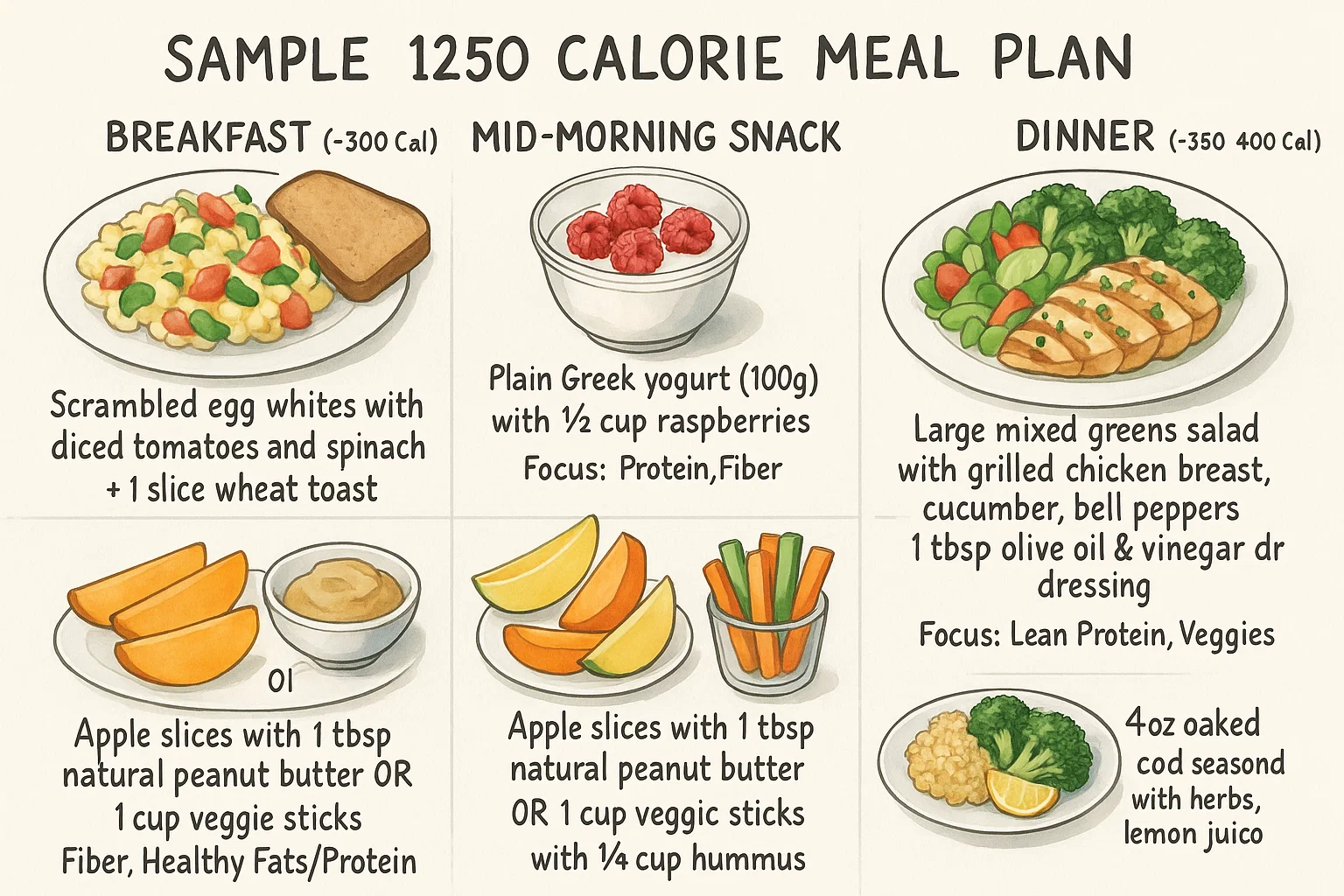
Okay, let’s visualize this nutrient-first approach. This is an ILLUSTRATION, NOT a prescription. Use it to understand the principles of balanced, protein-and-fiber-rich eating within a low budget, then tailor it (ideally with an RD!).
(Consider adding 1-2 compelling, high-quality food images here)
(The 7-day plan structure from the previous version is good, focusing on the descriptions and underlying principles rather than just the calorie count. Ensure portion sizes are mentioned as estimates requiring adjustment.)
Example Day (Focus on Principles):
- Breakfast (Aim: ~250-300 kcal): PRIORITIZE PROTEIN & FIBER. Example: Greek yogurt with berries and nuts OR scrambled eggs/tofu with spinach and whole-wheat toast. Why: Starts the day satiating, stabilizes blood sugar.
- Lunch (Aim: ~350-400 kcal): LEAN PROTEIN + TONS OF VEGGIES. Example: Large salad with grilled chicken/salmon/beans, lots of greens/colorful veggies, light vinaigrette OR a hearty lentil soup with veggies. Why: Keeps you full, provides micronutrients.
- Dinner (Aim: ~400-450 kcal): BALANCED PLATE. Example: Baked fish/chicken/tofu with a large portion of roasted/steamed vegetables (broccoli, asparagus) and a small portion of complex carb (quinoa, sweet potato). Why: Satisfying end to the day, provides sustained energy.
- Snack(s) (Aim: ~150-200 kcal total): PROTEIN and/or FIBER. Example: Apple with almond butter OR cottage cheese with cucumber OR a hard-boiled egg OR a small handful of nuts. Why: Bridges gaps, prevents overeating at meals.
| Day | Theme Principle | Focus Areas |
| 1 | Balance Kickstart | Protein, Fiber, Veggies |
| 2 | Protein Power | Lean Protein Emphasis, Veggies |
| 3 | Plant-Focused Fuel | Plant Proteins (Beans, Lentils, Tofu), Fiber |
| 4 | Satisfying & Simple | Balanced Macros, Easy Prep |
| 5 | Light & Fresh | Lean Protein (Fish/Shrimp), Veggies, Hydration |
| 6 | Flavor Kick | Herbs/Spices, Lean Protein, Veggie Volume |
| 7 | Comfort Twist | Healthy Swaps (Squash vs Pasta), Protein, Fiber |
Remember: Calorie counts are estimates. Focus on food quality and listen to your body.
A Week-Long Sample Meal Plan for a 1250 Calorie Diet (table format)
Designed to be engaging and informative, this plan features a variety of delicious and nutritious meals!
| Day | Theme | Breakfast (Calories) | Morning Snack (Calories) | Lunch (Calories) | Afternoon Snack (Calories) | Dinner (Calories) |
|---|---|---|---|---|---|---|
| 1 | Kickstarting Your Diet | 230 – Measured breakfast for sodium & fiber | 50 – Light snack to curb hunger | 350 – Satisfying, sodium-conscious lunch | 120 – Slightly larger afternoon snack | 500 – Fulfilling dinner within sodium limit |
| 2 | High-Protein Focus | 250 – Protein-rich breakfast for energy | 70 – Protein snack for metabolism boost | 330 – High-protein lunch keeping you on track | 100 – Small apple for refreshment and fiber | 500 – Vegetable stir-fry with tofu for protein and satisfaction |
| 3 | Plant-Based Choices | 200 – Energizing smoothie with spinach & fruit | 50 – Crunchy, hydrating carrot & cucumber salad | 400 – Protein & fiber-packed quinoa salad | 100 – Almonds for healthy fats & protein | 500 – Balanced grilled chicken, broccoli, & quinoa |
| 4 | Balanced and Satisfying | 220 – Scrambled eggs with spinach & whole-grain toast | 80 – Greek yogurt with berries for calcium & protein | 300 – Filling turkey & avocado wrap | 150 – Mixed berries for fiber & antioxidants | 500 – Baked salmon with lemon, dill, asparagus, & potato |
| 5 | Keeping It Light and Fresh | 210 – Refreshing spinach, banana, & berry smoothie | 90 – Crisp apple for fiber and water | 310 – Colorful salad with protein-packed hard-boiled egg | 140 – Greek yogurt with honey & cinnamon | 500 – Grilled chicken, quinoa, & steamed broccoli |
| 6 | Flavorful and Filling | 230 – Omelet with spinach, mushrooms, & cheese | 60 – Handful of almonds for healthy fats & protein | 360 – Turkey & avocado wrap packed with nutrients | 100 – Carrot sticks with hummus for satisfaction | 500 – Baked salmon with lemon, dill, brown rice, & green beans |
| 7 | Comfort Food with a Healthy Twist | 240 – Oatmeal with blueberries & chia seeds | 50 – Juicy peach for hydration | 350 – Hearty quinoa salad with black beans, corn, peppers, & cilantro | 110 – Almond butter & celery sticks for energy & satisfaction | 500 – Balanced dinner of grilled chicken, broccoli, and quinoa |
Essential Tips for Success on a 1250 Calorie Diet
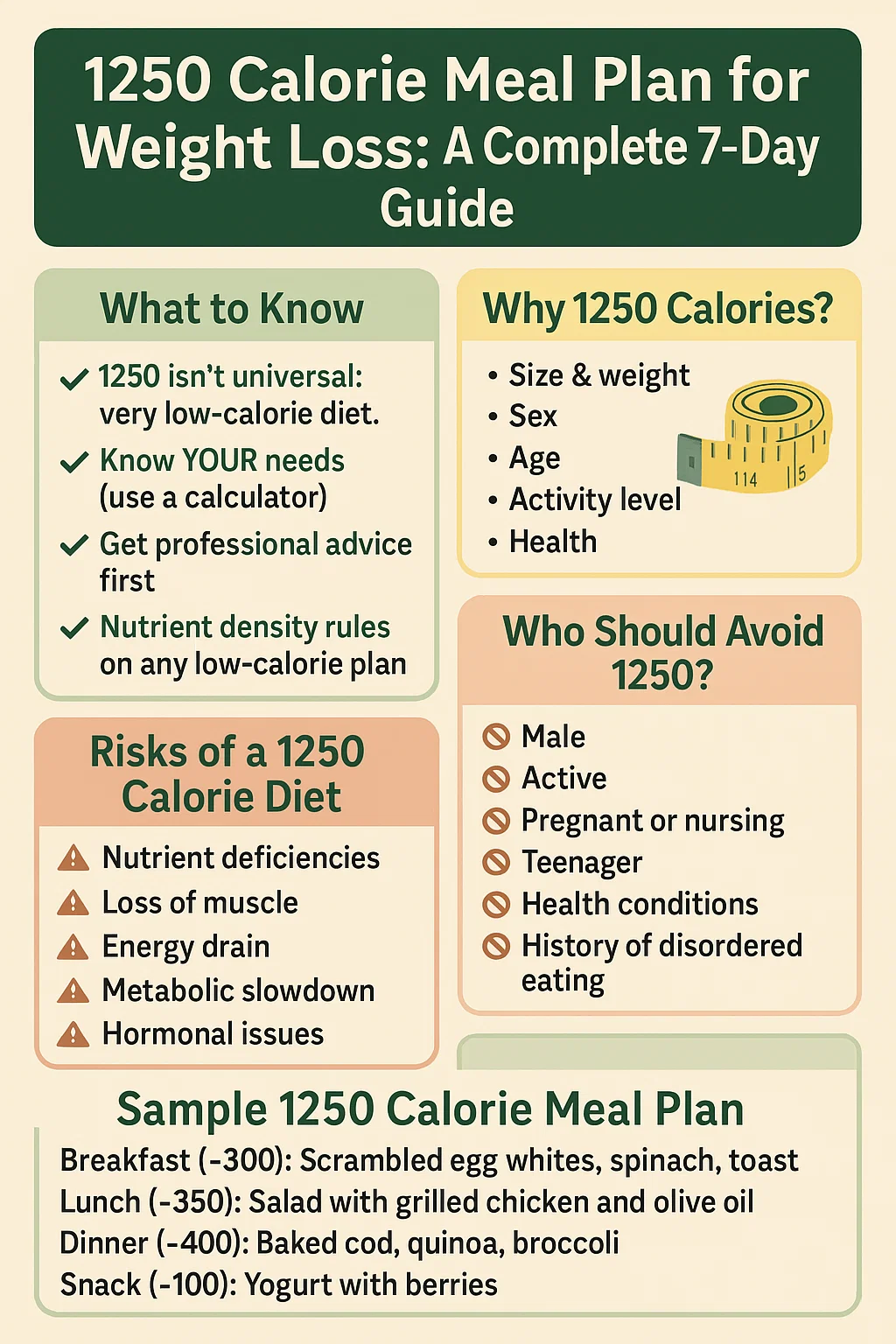
Success on a 1250 calorie diet requires careful planning and mindfulness. I make sure to include a variety of foods to get all the essential nutrients. Consulting a registered dietitian helped me understand the importance of balanced nutrition and avoid common pitfalls like nutrient deficiencies.
How to Avoid Common Pitfalls in Low-Calorie Diets
One common mistake in low-calorie diets is neglecting protein intake and fiber-rich foods. I focus on incorporating lean protein and plenty of vegetables in my meals to stay full and satisfied. This strategy helps me avoid feeling deprived or tempted to binge eat.
Smart Snacking on a 1250 Calorie Meal Plan
Smart snacking is key to staying on track. I choose snacks like cottage cheese with cucumber slices, which are low in calories but high in protein and hydration. These snacks help me maintain my energy levels and prevent overeating during meals.
Tips for Success on a 1250 Calorie Meal Plan
| Tip | Description |
|---|---|
| Consult a registered dietitian | They can help create a personalized plan and ensure you’re getting all the nutrients you need. |
| Focus on protein and fiber | These nutrients help you feel full and satisfied, reducing cravings. |
| Choose lean protein sources | Chicken, fish, beans, and tofu are all good options. |
| Eat plenty of fruits and vegetables | They are low in calories and packed with nutrients. |
| Include healthy fats | Avocados, nuts, and seeds provide healthy fats and help with satiety. |
| Drink plenty of water | Aim for at least 8 glasses per day. |
| Be mindful of portion sizes | Use measuring cups and spoons to ensure you’re not overeating. |
| Meal prep | This can save you time and help you stay on track. |
| Find healthy recipes | Explore new recipes to keep your diet interesting. |
| Stay active | Regular exercise is essential for weight management and overall health. |
Tailoring Your Plan for Weight Loss: Can a 1200 Calorie Indian Diet Plan Work?
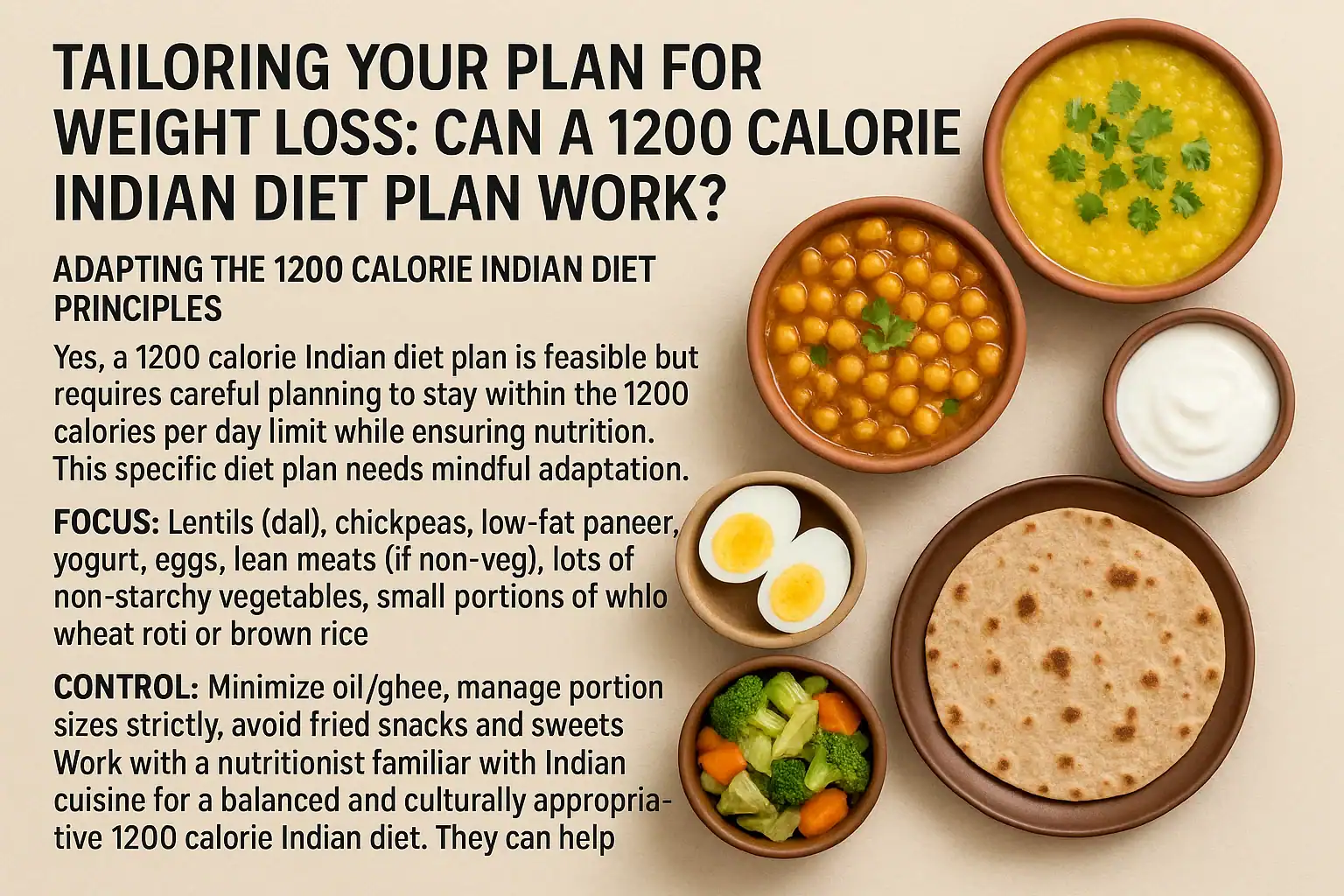
Adapting the 1200 Calorie Indian Diet Principles
Yes, a 1200 calorie Indian diet plan is feasible but requires careful planning to stay within the 1200 calories per day limit while ensuring nutrition. This specific diet plan needs mindful adaptation.
- Focus: Lentils (dal), chickpeas, low-fat paneer, yogurt, eggs, lean meats (if non-veg), lots of non-starchy vegetables, small portions of whole wheat roti or brown rice.
- Control: Minimize oil/ghee, manage portion sizes strictly, avoid fried snacks and sweets.
- Consult: Work with a nutritionist familiar with Indian cuisine for a balanced and culturally appropriate 1200 calorie Indian diet. They can help create a personalized meal plan that meets your needs and preferences while sticking to the calorie goal.
Beyond the 1200 Calorie Diet Plan: Making Food Work for You
Practical Tips to Lose Weight Sanely
- Plan & Prep: Cook batches of lean protein, grains, chop veggies. Meal prep is your best friend.
- Smart Swaps: Use herbs, spices, lime juice, vinegar for flavor.
- Portion Control: Use smaller plates, measure servings initially. Understanding portion sizes is key.
- Hydrate Well: Water aids metabolism and fullness.
- Move: Combine your diet meal plan with appropriate physical activity.
Why This Isn’t a Forever Diet Plan
This needs repeating: A severe low-calorie diet like the 1250 calorie meal plan or a 1200 calorie diet plan is not a long-term solution for most active people. 1200 calories per day may be too low for sustained energy and overall health.
Think of it as a temporary tool, if necessary and supervised. The real aim is sustainable healthy habits:
- A balanced diet you enjoy.
- Mindful eating.
- Regular movement you like.
- Stress management and good sleep.
Focus on a healthy lifestyle and overall health, not just hitting a low number on a restrictive diet plan.
Final Pour: Ditching the Number Game
That 1250 number glitters, promising fast results. But look deeper. Question the quick fix. Prioritize your health, energy, and finding a way to lose weight that doesn’t feel like punishment. The 1250 calorie meal plan is a strict tool, often too blunt for the job. Get personalized, professional guidance from a nutritionist or doctor. Focus on quality food and habits you can live with. That’s the path to lasting fitness.
References
- National Institutes of Health (NIH) – Body Weight Planner: https://www.niddk.nih.gov/bwp – Estimates calorie needs for weight goals.
- GearUpToFit – TDEE Calculator: https://gearuptofit.com/fitness-and-health-calculators/the-best-tdee-calculator/ – Calculate your personal daily energy expenditure.
- Academy of Nutrition and Dietetics: https://www.eatright.org/ – Find a registered dietitian.
- Centers for Disease Control and Prevention (CDC) – Healthy Weight, Nutrition, and Physical Activity: https://www.cdc.gov/healthyweight/ – General guidelines on healthy weight.
- GearUpToFit – Weight Management Through Healthy Eating: https://gearuptofit.com/nutrition/weight-management-through-healthy-eating/ – Focus on sustainable habits.
- GearUpToFit – Calculate Macronutrients for Weight Loss: https://gearuptofit.com/fitness-and-health-calculators/calculate-macronutrients-for-weight-loss/ – Tool for macro breakdown.
- GearUpToFit – High Protein Low Calorie Foods: https://gearuptofit.com/nutrition/high-protein-low-calorie-foods/ – Nutrient-dense food ideas.
- GearUpToFit – Meal Planning for Weight Loss: https://gearuptofit.com/nutrition/meal-planning-for-weight-loss/ – Tips on planning meals.
- GearUpToFit – How to Make Health and Fitness a Lifestyle: https://gearuptofit.com/fitness/how-to-make-health-and-fitness-a-lifestyle/ – Focus on long-term habits.
- GearUpToFit – The Essential Vitamins Your Body Needs: https://gearuptofit.com/nutrition/the-essential-vitamins-your-body-needs/ – Importance of micronutrients.
